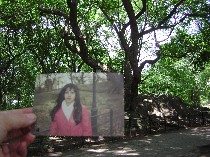
I hardly know how to begin to tell you about Janet Cardiff’s piece, “Her Long Black Hair,” a walk through part of Central Park mediated by a soundtrack, which offers up a mix of narrative mystery, sound effects, directions and thoughts.
The park itself provides the visuals along with five photos that we got (top, one of the five photos plus a little park). The park also provides unrehearsed sounds that augment the CD.
 We (Roberta, her daughter Stella and her sister Cate) started out at the Public Art Fund, the sponsor for “Her Long Black Hair,” and worked our way up to the usual departure point, which would be at a green kiosk on the southeast edge of the Park (left the kiosk, at rest and closed up on its day off).
We (Roberta, her daughter Stella and her sister Cate) started out at the Public Art Fund, the sponsor for “Her Long Black Hair,” and worked our way up to the usual departure point, which would be at a green kiosk on the southeast edge of the Park (left the kiosk, at rest and closed up on its day off).
The sights of the city
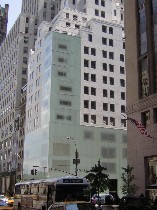
On our way there, we looked at an old building modernized with a glass skin (right)
…
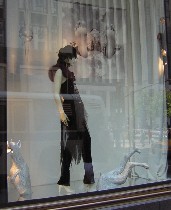
we observed fashion windows in Bergdorf Goodman that would set Philadelphia matrons scowling (left)
…
and we watched a young woman dolled up in her short pink dress (strapless at midday) cross the street and draw stares (right).
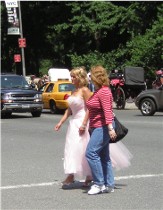
But then we followed our instructions, sat down on a bench and turned on our Walkmans, the sound track competing with the real-life sirens. Suddenly, I wasn’t sure what was real, what was Memorex.
Lost in time
Roberta and I had both taken a Cardiff walk at the Carnegie International in Pittsburgh which included little videos as well as sound, and a surreal sense of secret places and lives, some of which took place simultaneously and yet in the past or maybe over and over. We got lost a couple of times, but not far enough lost for it to matter.
The Central Park walk relied mostly on sound. But being in the present and the past simultaneously was still a hallmark of the experience. We did not get lost this time.
Having the sound tell you about where you are and dictate to you what to notice mediates your normal experience of taking a walk. It makes you part of a semi-planned experience in which reality and unreality merge. The people you pass in Central Park are real, as are the shrubs. But they fill roles within the unreal story.
 The disembodied voice on your CD tells you that she hopes you see the egret fly over the water, or warns you that a homeless person surrounded by plastic bags filled with possessions is on the bench ahead–and then you see the egret and a homeless man (here’s the egret).
The disembodied voice on your CD tells you that she hopes you see the egret fly over the water, or warns you that a homeless person surrounded by plastic bags filled with possessions is on the bench ahead–and then you see the egret and a homeless man (here’s the egret).
The merger of life and art
 Sometimes the narrator offers what seems like a random prediction and voila, it comes true right before your eyes–the man reading a newspaper, the man on skates (just as the CD plays in your ear a skater warning you to watch out–a warning recorded at some other time).
Sometimes the narrator offers what seems like a random prediction and voila, it comes true right before your eyes–the man reading a newspaper, the man on skates (just as the CD plays in your ear a skater warning you to watch out–a warning recorded at some other time).
Footsteps from another day and another walker echo in the background when you walk; a voice that comes from right behind you asks if you’ll take a picture of him and you look back to see no one there and realize the voice was on the CD; the main narrator’s voice urges “Don’t look back” in your ear.
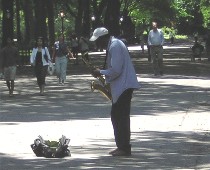 My favorite pairing of recording and life was the rapper on the CD just as we came upon a real-life saxiphone player (left) riffing a jazz melody. I suddenly pictured myself in a Greenwich Village Beat Generation hot spot.
My favorite pairing of recording and life was the rapper on the CD just as we came upon a real-life saxiphone player (left) riffing a jazz melody. I suddenly pictured myself in a Greenwich Village Beat Generation hot spot.
The recording technique Cardiff uses is called binaural sound. It tricks you believing you have located the source of the sound–the voice from over your shoulder, the warning from several feet in front of you, the music from a band just out of sight. We are unaccustomed to this level of realism in normal recordings.
An afterthought–the story
Behind the concurrences of CD and life was a fragmentary story–a sort of mystery or search to explain the five photographs, four featuring a woman with long black hair, the photos taken along the path we took . We are following her, and she becomes identified with Euridyce (she who wasn’t supposed to look back, just like us), as Central Park, a few steps down from the street level, becomes the underworld. We are not sure if the female voice on the CD is jealous of her, is in love with Orpheus or what.
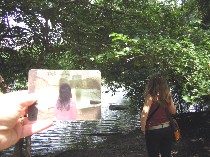 In the end, arias from the opera “Orfeo” swell as we stand in the same spot as Euridyce in the final picture, overlooking the pond (right, Stella in her real life and Euridyce in Cardiff’s photo looking over the same spot).
In the end, arias from the opera “Orfeo” swell as we stand in the same spot as Euridyce in the final picture, overlooking the pond (right, Stella in her real life and Euridyce in Cardiff’s photo looking over the same spot). On the way to this final spot, we are given quotes from Baudelaire and Kirkegaard, some information about Central Park’s visionary creator, Fredrick Law Olmstead, some thoughts about what someone in the Civil War era might have experienced is they walked on our path.
The nature of time and repeating lives and real and not real became the leitmotifs of the walk, along with the fragments of the story and the bits of park history.
Included in my press packet was an interview between Janet Cardiff (who is a Canadian) and Canadian filmmaker Atom Egoyan. He said that the first piece of hers he had encountered made him feel like he was in the middle of a film being formulated. “Her Long Black Hair” also had a movie feel, but it’s more interactive than a movie, taking you out of your own perspective and life and movie-theater seat and sending you on Cardiff’s walk. She’s the director. You’re an actor. But some of the possibilities of what will happen in this film are forever undecided.
I’m wondering if walks are the next big art thing. I’m thinking here about Laurie Anderson taking walks and trying to figure out how to turn them into art. As for my own walks, I doubt that they’re art, but they do contain their own inner monologue of observations and meditations.
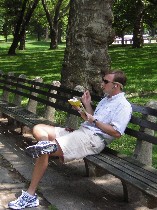 People who take their walks listening to a recording of some sort don’t have the same sort of walking experience–the inner monologue, but this walk gave a mix of inner and outer that fed on eachother when the mix was just right.
People who take their walks listening to a recording of some sort don’t have the same sort of walking experience–the inner monologue, but this walk gave a mix of inner and outer that fed on eachother when the mix was just right.
(I suppose this man sitting in the park (left) with his earphones on and his nose in a book is not having the same sort of park-sitting experience that someone tuned in to what’s around them might have. And I suppose some pedestrian, seeing the four of us with our earphones on might have had the same thought about us.)
I hope you can get to New York to see this piece before it closes Sept. 13.









